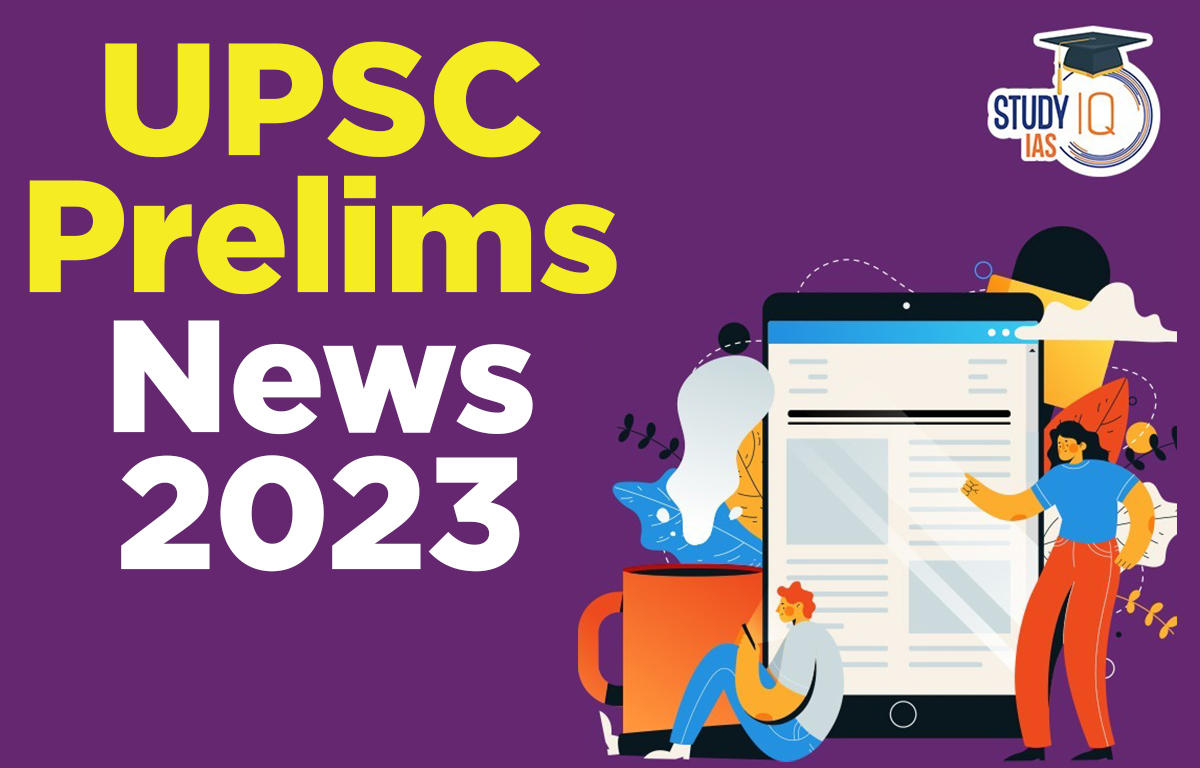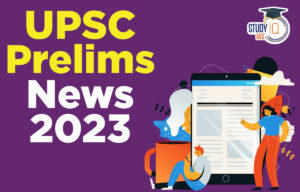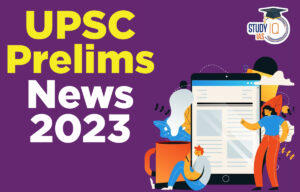UPSC Prelims News of 9 March 2023
Real-Time Train Tracking
Context: The Indian Railways has recently tied up with ISRO for real-time train tracking, leveraging on data analytics and satellite Imagery.
About Real-Time Train Tracking
- The Indian Railways has commenced a project, which will now enable real time tracking of train movements with the assistance of satellite imagery under the Real Time Train Information System (RTIS) project.
- Collaboration: The Railways has collaborated with Indian Space Research Organization (ISRO) for live tracking to help Railways run trains efficiently.
- Technology: The ISRO developed Navigation with Indian Constellation (NavIC) and Bhuvan (a web-based utility) allows users to explore a set of map-based content being deployed for tracking.
- Significance: Real time tracking of trains is useful during accidents, floods and landslides, when there is a need to pin down the train’s exact location for rendering help.

UPSC Prelims News 7 March 2023
Shoonya Campaign
Context: Shoonya is a consumer awareness campaign to reduce air pollution by promoting the use of electric vehicles (EVs) for ride-hailing and deliveries.
More on the News:
- The campaign has 130 industry partners, including ride-hailing, delivery and EV companies.
- It will make it easier for e-commerce businesses to differentiate their products from their rivals.
Advantages
- Last-mile deliveries: India’s online shopping sector expanded, and by 2022 it is anticipated to reach $150 billion.
- This has significantly increased the networks of delivery trucks by moving the end-transportation of items further from the customer.
- Cut Emissions: 10% of India’s freight transit CO2 emissions are accounted for by urban freight vehicles, and by 2030, these emissions are projected to increase by 114%.
- The absence of tailpipe emissions from EVs can significantly improve air quality.
- They release 15–40% less CO2 and cost less than engines that use internal combustion, even when manufacturing costs are considered.
- Energy Security: Moving to electric vehicles (EVs) can help India decrease its reliance on foreign oil, address the issue of energy shortages, and transition to renewable and sustainable energy sources.
Consumer Court
Context: Recently, Supreme Court used its powers under Article 142 to reduce the mandatory professional experience from 20 to 10 years to preside over consumer courts.
About Consumer Court
- They are established in India to resolve and decide issues under the Consumer Protection Act, 2019.
- These courts have been set up at the district, state, and national levels.
- Each Court has a set legal valuation.
- District Courts shall have jurisdiction to entertain complaints where value of the goods or services paid as consideration does not exceed 50 lakh rupees.
- State Courts shall have jurisdiction to entertain complaints where value of the goods or services paid as consideration exceeds 50 lakh rupees but does not exceed 2 crore rupees.
- National Court shall have jurisdiction to entertain complaints where value of the goods or services paid as consideration exceeds 2 crore rupees.
Type of Consumer Cases That Go to Court
- A consumer court hears cases involving a disagreement between a consumer and a trader or seller
- The cases must involve either poor service, harmed goods or services, unfair or restricted business activities, or damaged goods.
- A consumer court may handle cases involving the general public in the range of consumer disputes. Consumer commissions have the power of civil courts in many aspects.
Article 142 of the Constitution
- Article 142 provides discretionary power to the Supreme Court, as it states that the Supreme Court in the exercise of its jurisdiction may pass such decree or make such order as is necessary for doing complete justice in any cause or matter pending before it.
Quantum Computing
Context: NASA’s Jet Propulsion Laboratory has developed a quantum detector that can transform how quantum computers exchange huge quantities of quantum data.
About Quantum Computing:
- Quantum computing is a form of computing which employs technology based on quantum theory.
- Quantum theory explains the behaviour of energy and material on the atomic and subatomic levels.
- Employment of quantum theory will make computers work far beyond their binary code (where they can only process information in bits that take the value of 1 or 0), while consuming lesser amounts of energy.
- Quantum computing is based on two features of quantum physics: Superposition and entanglement.
- Superposition means the ability of a quantum system to exist in multiple states at the same time. Entanglement, on the other hand, is the ability of two members of a pair (Qubits) to exist in a single quantum state.
- Benefits & Applications of Quantum Computing
- o Disaster Management: Early and timely collection of climate data may help reduce catastrophes in their initial stages.
- o Secure communication: They find application in Satellites, Military purposes, Cyber security, Internet of Things, Big Data, Artificial Intelligence.
- Research: They help in Biological research such as genome sequencing and tailored medicine delivery and also scientific research on the universe, gravitational waves, and black holes.
- Challenges of Quantum Computing: Skill development issues, huge investments in R&D and Infrastructure, ethical concerns like replacement of humans by advanced machines etc.

Initiatives to Promote Quantum Computing:
- National Mission on quantum technologies and applications: The Government in its 2021 budget allocated INR 8000 Crore towards the National Mission on quantum technologies and applications to induce developments in quantum computing, cryptography, communications, and material science.
- Quantum Computing Laboratory: The Indian Army set up a quantum computing laboratory and an AI centre at a military engineering institute in Madhya Pradesh in 2021. It is also backed by the National Security Council Secretariat (NSCS).
- Quantum Communication Lab: The Centre for Development of Telematics (C-DOT) launched a quantum communication lab in 2021 that can support more than 100 km of standard optical fibre.
- Collaborations: The Defence Institute of Advanced Technology (DIAT) and the Centre for Development of Advanced Computing (C-DAC) agreed to collaborate and develop quantum computers.
- I-HUB Quantum Technology Foundation: The Department of Science and Technology and about 13 research groups from IISER Pune launched I-HUB Quantum Technology Foundation (I-HUB QTF) to further enhance the development of quantum tech.
Durung-Drung and Pensilungpa Glaciers
Context: Durung-Drung and Pensilungpa glaciers in Ladakh’s Zanskar Himalayas have retreated by 10% and 8% in 48 years.
About Durung-Drung and Pensilungpa glaciers:
- Durung-Drung and Pensilungpa have retreated by 7. 8 sq km and 1. 5 sq km respectively between 1971 and 2019.
- Both glaciers feed important tributaries of the Zanskar river.
- Apart from climate change, glacier retreat is also influenced by topographic settings and morphology.
- The Pensilungpa Glacier (PG) in the Suru River basin and the Durung-Drung Glacier (DDG) in the Doda River basins of Zanskar range are located in the Leh district of Ladakh.
Zanskar Range
- The Zanskar Range is a mountain range in the union territory of Ladakh that separates Zanskar from Ladakh.
- Geologically, the Zanskar Range is part of the Tethys Himalayas.
- Marbal Pass and many other passes which connect Ladakh with Kashmir are in this area.
- 13000 feet high Zojila Pass is in the extreme northwest of the Zanskar range.

Moon’s Own Time Zone
Context: With more lunar missions than ever on the horizon, the European Space Agency wants to give the moon its own time zone.
About Moon’s Own Time Zone
- Time on Earth is precisely tracked by atomic clocks, but synchronizing time on the moon is tricky because clocks run faster there, gaining around 56 microseconds, or millionths of a second, per day.
- Once a new lunar time zone is established, the methods used to create it will be useful for future space exploration.
- Right now, without a standard lunar time, each moon mission runs on the time of the country that is operating the spacecraft.
NISAR
Context: Recently, the Indian Space Research Organisation (ISRO) has received the NASA-ISRO SAR (NISAR) satellite from the U.S. space agency.
About NISAR
- NISAR is a Low Earth Orbit (LEO) observatory jointly developed by NASA and ISRO.
- It is expected to be launched in January 2024 from Satish Dhawan Space Centre into a near-polar orbit.
- The satellite will operate for a minimum of three years.
- NISAR will map the entire globe in 12 days.
- It will provide spatially and temporally consistent data for understanding changes in Earth’s ecosystems, ice mass, vegetation biomass, sea level rise, groundwater and natural hazards, including earthquakes, tsunamis, volcanoes and landslides.
Features
- It is a 2,800 kilograms satellite consisting of both L-band and S-band Synthetic Aperture Radar (SAR) instruments, which makes it a dual-frequency imaging radar satellite.
- NISAR carries L and S dual-band Synthetic Aperture Radar (SAR), which operates with the Sweep SAR technique to achieve large swaths with high-resolution data.
- SAR is capable of penetrating clouds and can collect data day and night regardless of the weather conditions.
- The SAR payloads mounted on Integrated Radar Instrument Structure (IRIS) and the spacecraft bus are together called an observatory.
- While NASA has provided the L-band radar, GPS, a high-capacity solid-state recorder to store data, and a payload data subsystem, ISRO (Indian Space Research Organisation) has provided the S-band radar, the Geosynchronous Satellite Launch Vehicle (GSLV) launch system and spacecraft.
- S band radars operate on a wavelength of 8-15 cm and a frequency of 2-4 GHz. This makes them useful for near and far range weather observation.
- It has a 39-foot stationary antenna reflector, made of a gold-plated wire mesh; the reflector will be used to focus “the radar signals emitted and received by the upward-facing feed on the instrument structure.

International Big Cat Alliance (IBCA)
Context: India is set to launch the International Big Cat Alliance (IBCA) for protection of big cats, under its leadership.
About IBCA
- Objective: The alliance aims to provide a platform for “dissemination of information on benchmarked practices, capacity building, resources repository, research and development, awareness creation”, etc., regarding the protection and conservation of big cats.
- Eligible species: Seven major big cats — tiger, lion, leopard, snow leopard, puma, jaguar and cheetah – will be covered under IBCA.
- Funding: The global alliance will provide assured support over five years with guaranteed funding of $100 million (over Rs 800 crore).
- After the initial five years, IBCA is expected to sustain itself through membership fees, and contributions from bilateral and multilateral institutions and the private sector.
- Membership: Membership will be open to 97 “range” countries, which host the natural habitat of these big cats, as well as other interested nations, international organizations, etc.
- Activities: Advocacy, partnership, knowledge e-portal, capacity building, eco-tourism, partnerships between expert groups and finance tapping.
- Governance structure: A General Assembly consisting of all member countries, a council of at least seven but not more than 15 member countries elected by the General Assembly for a five year term, and a Secretariat.
- The General Assembly will appoint the IBCA Secretary General for a specific term based on the recommendation of the Council.
- Criticism: Conservationists have criticized the huge funding as it is exceeds what India can apparently afford to spend for 22 species at the brink of extinction.
- Existing key landscapes and species recovery programmes are lagging behind due to inadequate funding.


 UPSC Prelims News 20 March 2023
UPSC Prelims News 20 March 2023
 UPSC Prelims News 17 March 2023
UPSC Prelims News 17 March 2023

















